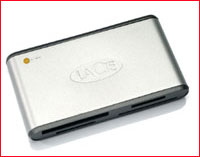Anyone shooting with a digital camera faces the issue of transferring the content of their memory cards to their computer, (usually CompactFlash for those with pro-level cameras).
There are three ways of doing this. If you have a laptop computer then the card can be inserted in to a PC Card adaptor and placed in that slot. Desktop as well as laptop computers may have eitherFirewireorUSB 2connectors, or both, and there are card readers available for both types of interfaces. (Don’t even think about using USB 1. It’s too slow. I also don’t care for using cables from the camera to the computer, as this can be a problematic interface, and also usually requires the manufacturer’s proprietary software to be installed).
The question then arises, which of the three preferred ways is faster, and are there any advantages to one method over the other?

Holland Marsh Heron. Ontario — August, 2003
Contax 645 with Kodak DCS Pro Back and
210mm f/4 Sonnar + 1.4X Mutar @ ISO 400
PC Card Readers
PC Card reader slots (or PCMCIA as they used to be called) in laptops are ubiquitous and convenient. Unfortunately, they are slow. More than 3 times slower than either Firewire or USB 2. Their advantage though, if you have a laptop, is that they require no additional devices since all laptops have them built in, and CompactFlash card adaptors are inexpensive and can live permanently in the card slot. Some laptop computers even have dedicated CF card readers slots. Regrettable these use the same PCMCIA card bus and offer no advantage other than to not require the use of a card adaptor.
Firewire
Firewire is fast. More than 3 times faster than PCMCIA transfers.
If you have a Mac then your computer has Firewire. You’re also lucky because it means that your computer has a full-sized powered Firewire connector and you can use self-powered card readers. Windows laptops that offer Firewire almost universally have mini-connector ports which arenotpowered, and therefore you need to use a card reader along with an AC adaptor. Not a problem on the desktop, and desktop PCs with Firewire typically have powered 6 wire plugs, but the AC adaptor is one more thing to carry in the field and means that you can’t transfer files while under battery power. Score one for the Mac.
USB 2
USB 2 card readers are about the same speed as Firewire; more than 3 times faster than PCMCIA slot transfers.
Their advantage for PC owners is that the USB 2 mini-connector on laptopsispowered, and so a USB 2 card reader doesn’t need an AC power block and cord, a serious weight and bulk saving when working on the road.
Timing Tests
I compared all three methods using aDell 8500laptop, a current model 2.2 Ghz Mobile Pentium 4 machine with 1GB of RAM. The test card was a 1GBIBM Microdrivecontaining 9 files, in a single 158 Megabyte directory.
Transferring these files took 140 second using the PCMCIA card slot, 43 seconds using aMicrotechFirewire card reader, and the same 43 seconds using aLacieUSB 2 card reader .
If you work with a current model laptop, especially in the field, a USB 2 card reader like theLacieappears to be the best solution. It’s what I currently use.
Update
Since this article was first published a new solution to high-speed transfers in the field has become available — theASKA Cardbus 32 SpeedOver— a high-speed CompactFlash PC card adaptor.
Update — October, 2003
Belkinhas introduceda card readerfor theApple iPod.This allows you to use your iPod for more than just playing tunes, copying your camera’s memory cards in the field via Firewire and under battery power. It $99 it is reasonably priced, and works with both Mac and Windows based Ipods.
You May Also Enjoy...
About the Luminous landscape
The AuthorThe author of this site isMichael Reichmann— a widely published photographer, author, and a photographic educator for much of the past 35 years. This
Next Generation
Epson — The Next Generation Update: July 26, 2000: A review of theEpson Stylus Photo 2000P, which uses the same inks and papers as the

